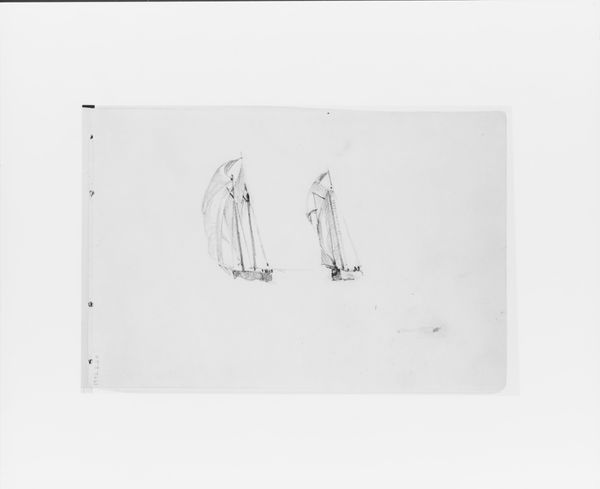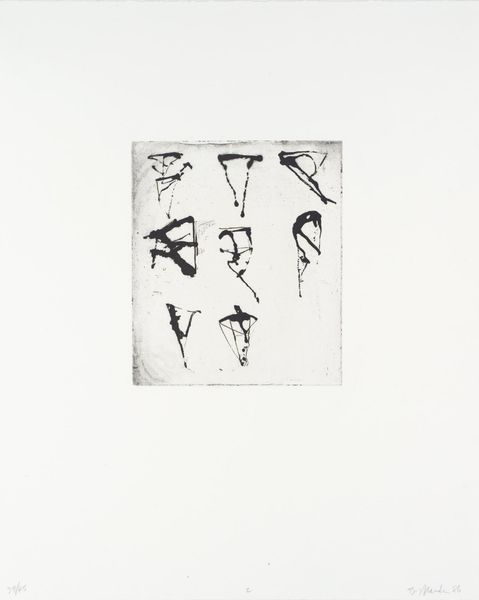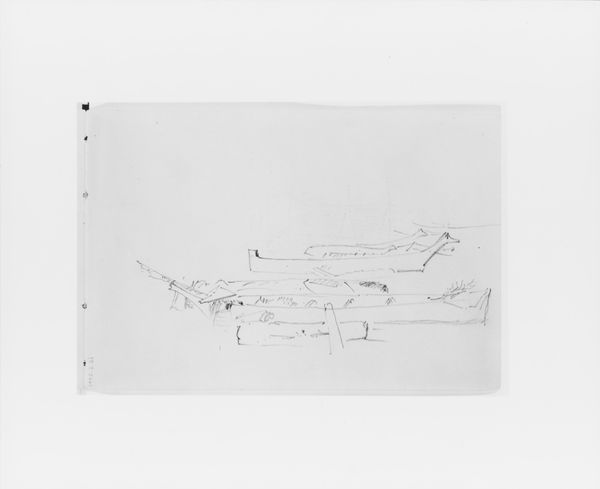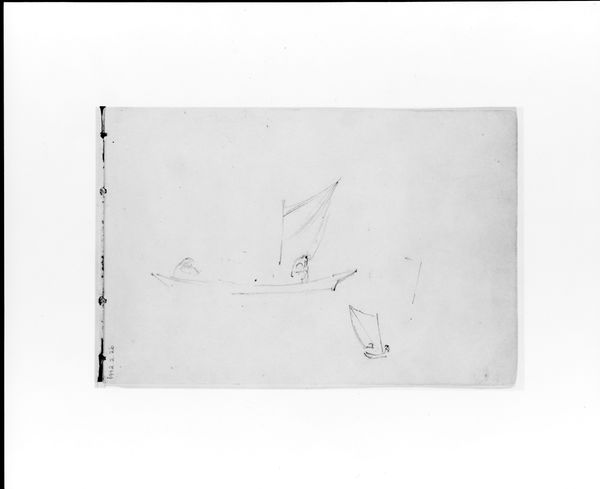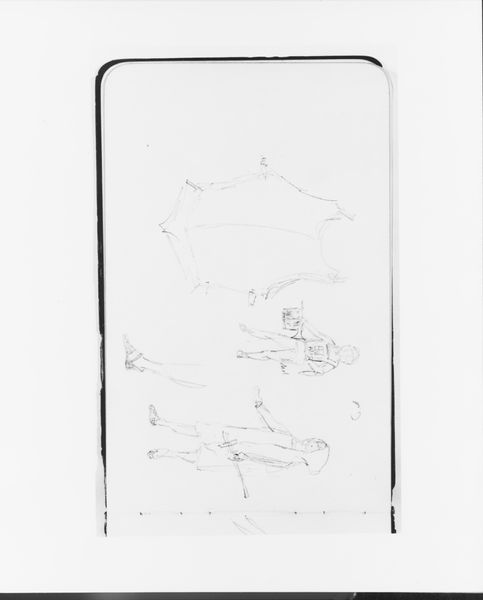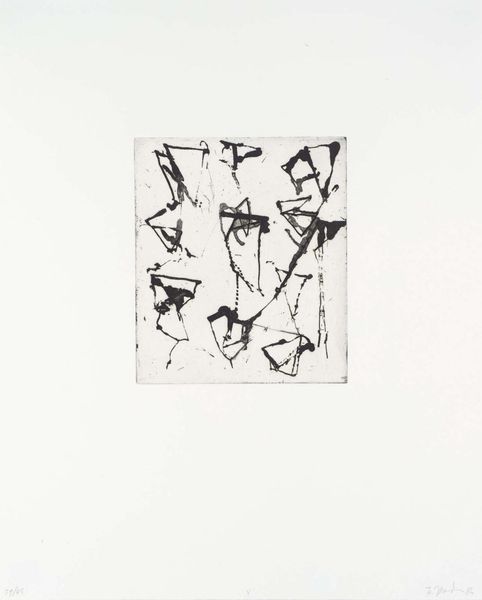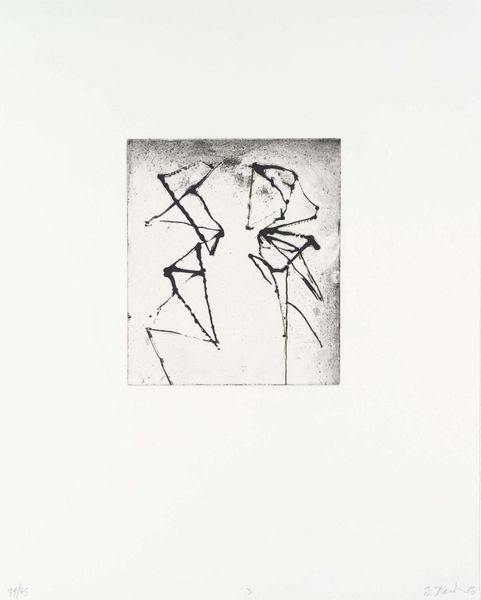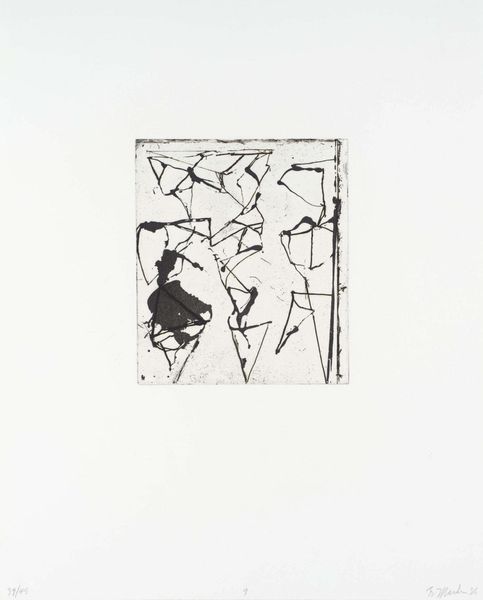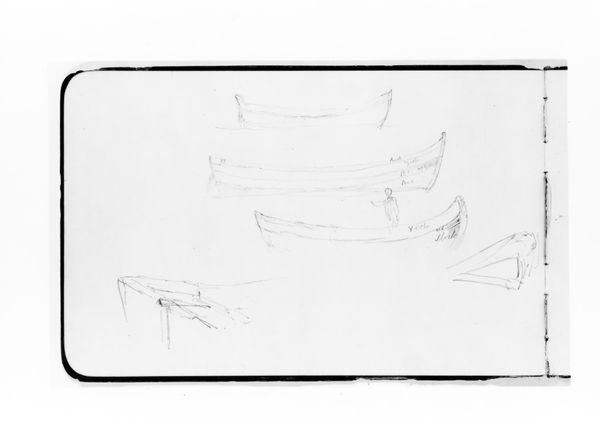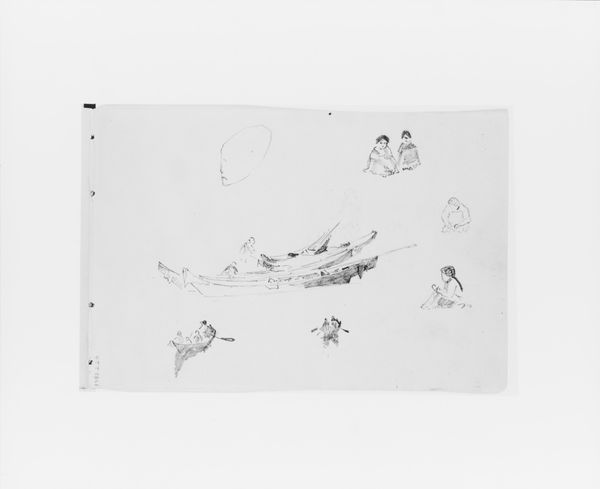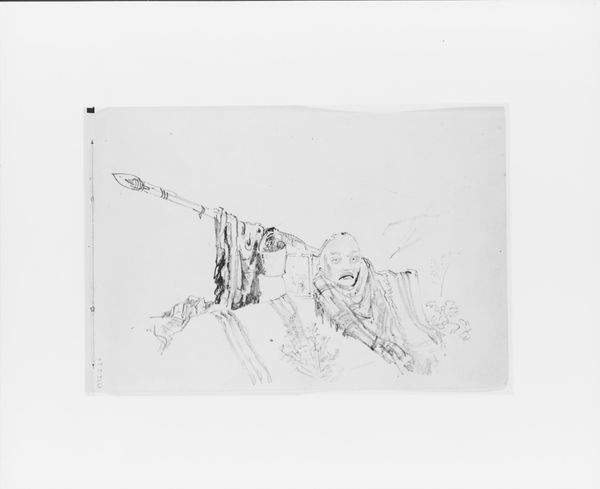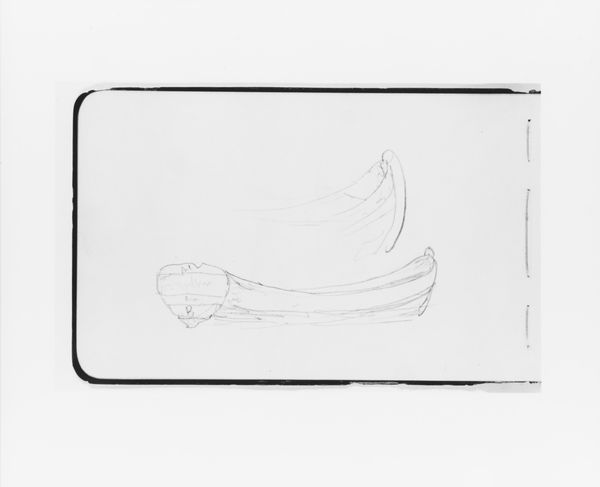![[no title] by Angus Fairhurst](/_next/image?url=https%3A%2F%2Fd2w8kbdekdi1gv.cloudfront.net%2FeyJidWNrZXQiOiAiYXJ0ZXJhLWltYWdlcy1idWNrZXQiLCAia2V5IjogImFydHdvcmtzLzI4MTVmMTdiLTkwMmEtNDQyNS1iNGRiLWE2ZjhjYzJmZTEzMy8yODE1ZjE3Yi05MDJhLTQ0MjUtYjRkYi1hNmY4Y2MyZmUxMzNfZnVsbC5qcGciLCAiZWRpdHMiOiB7InJlc2l6ZSI6IHsid2lkdGgiOiAxOTIwLCAiaGVpZ2h0IjogMTkyMCwgImZpdCI6ICJpbnNpZGUifX19&w=3840&q=75)
Dimensions: image: 195 x 333 mm
Copyright: © The estate of Angus Fairhurst | CC-BY-NC-ND 4.0 DEED, Photo: Tate
Editor: This untitled work by Angus Fairhurst features a simple comic strip style drawing. The figures are quite minimalist, almost childlike. What do you make of its seemingly simple presentation? Curator: It's interesting how Fairhurst uses this unassuming style, isn't it? Consider the era in which he was working; the late 20th century saw a rise in art that questioned traditional notions of skill and presentation. How do you think this work engages with the established art world? Editor: It definitely feels like a commentary, maybe even a gentle poke at the seriousness often associated with fine art? Curator: Precisely. The drawing style and the ambiguous narrative, framed within these comic-strip panels, could be interpreted as a subversive act. It challenges us to find meaning in the mundane and to question the value we place on artistic skill. Editor: So, it’s less about the drawing itself and more about what it represents culturally? Curator: Exactly! Fairhurst encourages us to look beyond the surface and to consider the socio-political context in which art is made and consumed. Editor: That's a helpful way to view it. I'll remember that. Curator: And I'm glad we could explore its context and implications.
Comments
Join the conversation
Join millions of artists and users on Artera today and experience the ultimate creative platform.
tate 8 months ago
⋮
Other Men's Flowers is a portfolio of text-based prints by fifteen London artists curated by Joshua Compston (1970-96). It was printed by Thomas Shaw and Simon Redington and published by Charles Booth-Clibborn under his imprint, The Paragon Press. Compston took the title, Other Men's Flowers, from an anthology of wartime poetry compiled by Field-Marshal Viscount Wavell (1883-1950) of the same title (published 1944). Wavell had derived the phrase from a well-known quotation attributed to French moralist Montaigne (Michel Eyquem de Montaigne, 1533-92), 'I have gathered a posie of other men's flowers and nothing but the thread which binds them is my own' (quoted in Cooper, p.115). Montaigne's original sentence, published in his Essais (Essays) in 1580, provided an apparently modest disclaimer, anticipating criticism of the originality of his ideas. For Compston, it provided an apt poetic metaphor for the role of the curator. Other Men's Flowers was launched at a party on 23 June 1994 in a derelict sawmill close to Hoxton Square, East London, a centre for young British artists at that time. Compston wrote in his press release: The project has produced an exciting and innovative publication that intrinsically embodies the elegant but underused printing technique of letterpress … that has allowed and encouraged many hitherto solely image-based artists an opportunity to operate within the realms of 'copy writing', providing them with a platform from which to sound off any phrase, slang discovery, polemical essay or related literary form … the participants produced works that responded to the given brief of a letterpress printed text piece. (Quoted in Cooper, p.116.) Letterpress is a form of relief printing in which paper is pressed, by either a large flat plate or rollers, onto previously inked type. In the event, nine of the fifteen participants adhered to Compston's letterpress brief. Of the remaining six, four produced screenprint images, one a lithograph and one a monotype. The individual artists used different types of paper, all of the same size, some working in landscape and others in portrait format. The portfolio was produced in two slightly different editions. The 'book' edition, of one hundred copies plus twenty artist's proofs, consists of fifteen prints, three title pages and a colophon page signed by all the artists, presented in a box. Tate's copy is number twelve in this edition. The 'portfolio' edition of fifty, plus twenty artist's proofs, differs only in that the prints are individually signed. The three title pages were designed by Compston and contain the following: the title words in large blue capitals, the words 'An Introduction to Other Men's Flowers' above a drawing of a pointing hand in the style of an Edwardian cartoon, the words 'Please Keep Out/ Foot & Mouth Precautions' in large red capitals copied from a National Union of Farmers poster of the 1960s. The colophon page, on which the artists, curator, printers and publishers are named and the editions described, bears the circled logo 'OMF' in red. This logo is a typical Compston mechanism and imitates his personal 'FN' (Factual Nonsense) logo. Compston set up Factual Nonsense, his gallery and project space, in Shoreditch, London in October 1992, shortly after graduating in art history from the Courtauld Institute in London. Aiming to establish a cultural revolution of some kind, he intended his space to be 'a forum for all elements disenchanted with the laxity and ennui of current thinking' (quoted in Cooper, pp.39-42). He befriended many members of the group of young British artists (or yBas) whose work was just coming to prominence in London at that time. Between 1993 and his tragically premature death in 1996 at the age of twenty-five, he organised exhibitions and performative day events in Hoxton Square, as well as commissioning the pages of Other Men's Flowers from his artist friends. Angus Fairhurst's contribution was printed by letterpress in landscape orientation on plain white paper. It is a cartoon made up of three boxes containing drawings. The first and last drawings - a large fish with a stick man hanging out of its mouth - are virtually identical. In the central drawing the man sits, elbows on knees and chin on hands. He and the fish are face-to-face as though contemplating each other. Above him are the words 'it's ok.'. The cartoon is printed over a rectangular area of grey. Repetition and jokes are central strategies in Fairhurst's work. In this instance, the repeated motif - a man preyed on by a fish, a reversal of the usual dynamic of man eating fish - is counterbalanced by the central image in which fish and man seem to be friends. Fairhurst has said: 'The punchline gives meaning to the structure, but is also the moment of deflation. … The pleasure of a joke is the parallel world that it creates. And the punchline ejects you from that parallel world. But without it you wouldn't have the confirmation that it was a parallel world.' (Quoted in Angus Fairhurst: The Foundation, p.44.) Further reading:Angus Fairhurst: The Foundation, exhibition catalogue, Ursula Blickle Stifutung, Kraichtal 1999Jeremy Cooper, no FuN without U: the art of Factual Nonsense, London 2000, pp.17, 21, 39, 79, 85, 89, 114-21, 180, 184-5 and 221, reproduced (colour) p.121 Elizabeth ManchesterJune 2002
